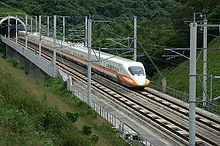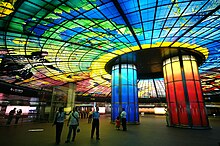Rail transport in Taiwan
| Taiwan (Republic of China) | |
|---|---|
| Operation | |
| Major operators | Taiwan Railways Administration |
| System length | |
| Total | 1,691 km (1,051 mi)[1] |
| Double track | 1,210 km (750 mi)[1] |
| Electrified | 1,372 km (853 mi)[1] |
| High-speed | 339 km (211 mi)[1] |
| Track gauge | |
| Main | 1,435 mm (4 ft 8+1⁄2 in) standard gauge |
| High-speed | 1,435 mm (4 ft 8+1⁄2 in) |
| 1,435 mm (4 ft 8+1⁄2 in) | 513 kilometres (319 mi) |
| Narrow gauge | 1,065 kilometres (662 mi) (1998) |
| Features | |
| Longest tunnel | Xinguanyin Tunnel 10.3071 kilometres (6.4045 mi) |
| Longest bridge | THSR Changhua-Kaohsiung Viaduct 157.317 kilometres (97.752 mi) |
Rail transport in Taiwan consists of 1691.8 km (as of 2015) of railway networks.[2] Though no longer as dominant as it once was, rail transport is an extremely important form of transportation in Taiwan due to high population density, especially along the densely populated western corridor. In 2011, over 863.4 million passengers used the rail systems in Taiwan, averaging 2.36 million passengers per day.[3]
The railways of Taiwan include conventional rail, rapid transit systems, and high-speed rail, as well as specialized railways for tourists and industry. Taiwan Railways Administration is an associate member and Taiwan High Speed Rail is an active member of the International Union of Railways (UIC), even though Taiwan does not have state membership.
Rail transport was introduced to Taiwan in 1891 during its late Qing era. Push car railways were brought to Taiwan during Japanese rule and were in general service from 1895 to the late 1940s.
The island of Taiwan is the only part of the present-day Republic of China to have rail transport (i.e., none of the small offshore islands—Kinmen, Matsu Islands, Pratas Islands, Penghu or Taiping—have rail transport).
Intercity railways
There are two operators that provide intercity services in Taiwan:
- Taiwan Railway Administration: TRA is the main operator of most passenger services and all freight services on Taiwan's 1067mm gauge traditional network. The various main lines form a loop around the island that connect most of the country's major cities, with small branch lines at various points to the interior. TRA operates both intercity trains throughout Taiwan, and commuter services into the major cities.
- Taiwan High Speed Rail: THSR operates services on the 1,435 mm (4 ft 8+1⁄2 in) gauge high-speed rail line connecting Taipei and Kaohsiung, on a route that runs on the western side of the island.
 |
 |
 |
 |
Urban metro
 |
 |
With the increasing urbanization of Taiwan, several urban rapid transit systems have been constructed with several more being planned.
| Name | Chinese Name | Year opened | Service status |
|---|---|---|---|
| Taipei Metro | 台北捷運 | 1996 | The Taipei Metro runs on an extensive network of VAL and elevated/underground metro systems throughout the metropolitan area of Taipei. |
| Kaohsiung Mass Rapid Transit | 高雄捷運 | 2008 | The KMRT operates a metro network throughout the metropolitan area of Kaohsiung. The Red Line is in operation as of 9 March 2008. The Orange Line opened on 14 September 2008. Another light rail system in downtown Kaohsiung is being built. |
| Taoyuan International Airport MRT | 台灣桃園機場 聯外捷運系統 |
2016[4] (under construction) | This line will connect from Taipei Main Station, throughing Taiwan Taoyuan International Airport, and THSR Taoyuan Station to Zhongli. |
| Taoyuan Metro | 桃園捷運 | 2016 (under construction) | A section of the route has merged into the Airport MRT System with the extension currently under construction. More lines are still being planned. |
| Taichung Metro | 台中捷運 | 2018 (under construction) | The Green Line project was approved in 2004. It is currently under construction and is scheduled for completion by 2018. |
| Tainan Mass Rapid Transit System | 台南捷運 | To be determined | The Ministry of Transportation and Communications declined the proposal in January 2010 for a metro in Tainan, citing budget issues and deeming it premature.[5] |
| Hsinchu Mass Rapid Transit System | 新竹捷運 | To be determined | Proposal declined along with that of the Tainan MRT.[5] |
Industrial and tourist railways

Originally built for the transportation of industrial products, these railroads have become tourist attractions.[6][7][8]
- Alishan Forest Railway: A narrow gauge railway that runs from Chiayi City to the popular mountain resort of Alishan. Originally built by the Japanese Colonial Government for the logging industry in 1912, this line now caters mostly to tourists.
- Taiwan Sugar Railways: An extensive series of narrow gauge lines mostly in central and southern Taiwan, originally built to haul sugarcane by Meiji Sugar Co., Ltd. during Japanese rule, but also capable of providing limited passenger service. Regular passenger services discontinued in 1982. In 2003, some short-distance train services resumed.
- Taiping Mountain Forest Railway: A short 3 km (1.9 mi), narrow gauge rail line running through the Taiping Mountain Scenic Area in Yilan County, originally constructed in 1924 for the logging industry, now a popular tourist attraction.
- Wulai Scenic Train: A short 1.6 km rail line running through mountains in Wulai District in New Taipei, originally constructed for logging and timber industry, now a popular tourist attraction.
Track gauge
The earliest railway in Taiwan was completed in 1893 under the auspices of Governor Liu Mingchuan during the Qing dynasty (see Taiwan Railways Administration§History). Since then, major railways in Taiwan have followed the 3 ft 6 in (1,067 mm) gauge standard. The Hualien–Taitung Line was once 2 ft 6 in (762 mm), but since 1982 it has been converted to 3 ft 6 in (1,067 mm), while the Alishan Forest Railway and the majority of Taiwan Sugar Railways are still 2 ft 6 in (762 mm) railways. The Taipei Metro, Taiwan High Speed Rail, and Kaohsiung Mass Rapid Transit all use standard gauge track.
Cultural
Because of the Taiwan's extensive rail network (including many now defunct industrial narrow gauge lines which provided passenger service to rural areas), railways in Taiwan often have a romantic connotation, especially amongst the older generation who remember growing up when rail travel was the primary means of transportation between cities in simpler (and less prosperous) times. Many remember leaving their hometowns to attend school in far away cities by train or leaving via train to perform their compulsory military service. This nostalgia has been capitalized upon in recent years through the introduction of various items such as "nostalgia railroad ekiben" (懷舊鐵路便當), claimed to be authentic copies of the box lunches that were once served aboard trains.
There is also a sizable network of railway fans in Taiwan which has increased with the recent trend of Taiwanization.
See also
References
- ^ a b c d (Chinese) "2014年铁道统计公报"
- ^ TRA+THSR+MRTs only
- ^ "Passenger Traffic of Railway in Taiwan Area". Ministry of Transportation and Communications. Retrieved 19 January 2011.
- ^ Gerber, Abraham (26 October 2014). "Airport MRT on schedule: Yeh". Taipei Times.
- ^ a b "捷運夢碎!八條輕軌遭退回!公車難經營 捷運路遙遠 台灣大眾運輸 阻礙重重!(MRT Dreams Shattered, Eight Light Rail System Proposals Declined)". Public Television Service. 19 January 2010. Retrieved 20 October 2011.
- ^ "Taiwan Train Travel". AsiaRooms.com. Retrieved 2 July 2010.
- ^ "Places to Visit". Council of Agriculture, Executive Yuan. Retrieved 2 July 2010.
- ^ "Nature". Taiwan.com.au. Retrieved 2 July 2010.
